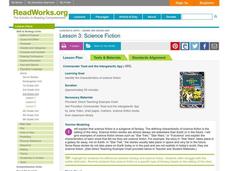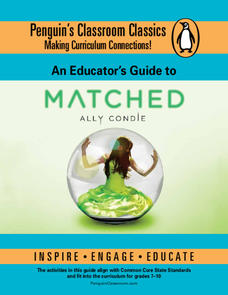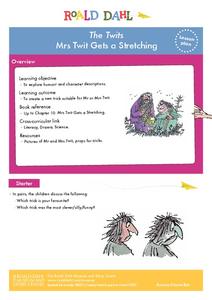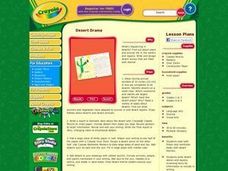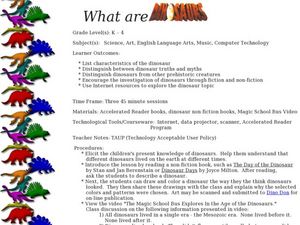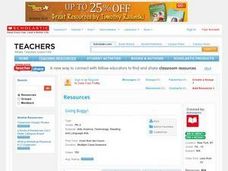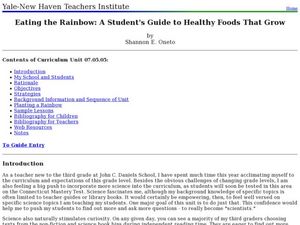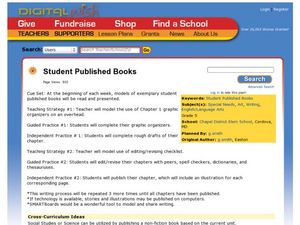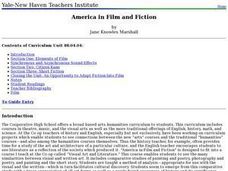Curated OER
Using a Chart to Track Book Sales
On this using a chart to track book sales worksheet, students use the chart for 6 types of books sold over a 6 day period to answer 8 fill in questions about interpreting the chart.
Curated OER
Science Fiction
Third graders explore the science fiction genre. In this genres lesson, 3rd graders identify the characteristics of science fiction. Students fill out a chart that shows the characteristics. Students read a selection from a book and talk...
Penguin Books
An Educator's Guide to Matched by Ally Condie
Even supposed Utopian societies have their flaws. Using an educator's guide, individuals explore the society Ally Condie creates in Matched. Reflective writing prompts double as discussion questions and cover key themes in the novel, as...
Roald Dahl
The Twits - Mrs Twit Gets a Stretching
A cork, a rubber snake, and a bucket of mud may not seem like the best materials for washing a car, but they are in The Twits. The fifth lesson in an 11-part unit designed to accompany The Twits by Roald Dahl has readers role play...
Curated OER
Desert Drama
Students read both fiction and nonfiction books with desert themes. Then they write desert stories and reports, reviewing texts for information to include in writing. Students also design desert scenes with details and setting elements...
Curated OER
Non-Fiction Read-aloud
Learners listen to the reading of a book about the area of science they are currently studying.
Baylor College
Modeling Earth's Atmosphere
Life on Earth is made possible by the unique composition of its atmosphere. Working collaboratively, a scale model is created as young scientists learn about the different layers of gas that surround the planet. Cards are included that...
Curated OER
Discussion Web: Ender's Game
Designed to encourage readers to consider both sides of of the question of whether Ender is responsible for the death of all the buggers, individuals search for examples from Orson Scott Card's popular science fiction novel, Ender's Game...
Curated OER
What are Dinosaurs?
Young scholars explore the attributes of dinosaurs. In this dinosaur lesson, students read books and watch videos featuring dinosaurs. Young scholars also research dinosaur traits using Internet sources.
Curated OER
Buoyant Behavior
Combine science and literature with this instructional activity on buoyancy. Read There's an Ant in Anthony by Bernard Most to examine words containing the letters a, n, and t. Then introduce your class to the word "buoyant."...
Curated OER
Going Buggy
Students identify the parts of a dragonfly that they drew. They write a very short non-fiction story (mainly with pictures) about the adventure of a dragonfly. They interview a person dressed as a dragonfly to find out some things about...
Curated OER
2105
Students read excerpts from Jon Scieszka's novel, 2095, prior to presenting their vision of the future in a creative project accompanied by written explanation. They design a museum exhibit which shows a scene from a science fiction book...
Curated OER
How-To Books
Students apply their knowledge and create a how-to book of their own. In this early childhood language arts worksheet, students learn about non-fiction books and write their own procedural non-fiction booklets.
Curated OER
Kid Lit Crit
Students explore different types of student literature; they then write their own fiction pieces, in either fantasy/adventure or memoir/realism style.
Curated OER
Eating the Rainbow: A Student's Guide to Healthy Foods That Grow
Third graders examine the nutritional value of different foods. In this health science lesson plan, 3rd graders create a daily log of the foods they eat and categorize them. They plan a healthy menu for their family.
Curated OER
Science Fiction
Young scholars write a science fiction story. In this science fiction lesson, students read selections of science fiction and compare them to supernatural stories from the Bible. Young scholars identify themes and discuss...
Curated OER
Compare and Contrast
Fourth graders read two books In this compare and contrast lesson plan, 4th graders read a science fiction or fantasy story and compare it to the story, "Help! I'm a Prisoner in the Library." Students also have the option to listen...
Curated OER
Student Published Books
Fifth graders create a graphic organizer after it is modeled by the teacher. In this graphic organizer lesson, 5th graders complete a graphic organizer describing chapter 1 of a book. Graphic organizers will be revised and...
Curated OER
America in Film and Fiction
Students begin the lesson by reading a book on film study. After watching the movie "Citizen Kane", they work together to identify the issues concerning the United States before World War II. As a class, they discuss how the ideas and...
Curated OER
Bird Stories: Fact or Fiction
Students evaluate/distinguish scientific fact from fiction. They discuss similarities and differences in the life cycles of various birds. Student use the Internet as a research tool.
Curated OER
Lions and Tigers and Bears - Oh My!
Research animals and develop a non-fiction presentation. Students will complete research on a particular animal and determine the animal's characteristics as well as habitat before choosing a differentiated project to present using the...
Curated OER
The Life Cycle of the Butterfly
First graders, after listening to fictional and non-fictional literature about caterpillars, and observing caterpillars from egg to butterfly, write a "biography" of a caterpillar using appropriate vocabulary and time lines.
Curated OER
Endangered Species... It's Not Too Late
Students choose an endangered species to research and report on. In this endangered species lesson, students complete a worksheet to gather information about their endangered animal and then use to write a book about the animal and...
Curated OER
Plants are Growing and Changing
Students explore living things. In this agriculture lesson plan, students read the book A Tree is a Plant and participate in an experiment to explore the patterns of change in living things. Students continue to observe the plant...

